Three warbler species are particularly hard to identify in the fall, when young birds and females predominate. The spring males of these species are quite distinctive.
The first of this "Treacherous Triad" is the Blackpoll. Sole reliance on Reed's color rendering would have placed a bird watcher who encountered an immature bird at a great disadvantage. No warbler looks anything like the one in the upper right in his illustration, described as paler than the female which is "greenish above streaked with black."

Next, in describing the Bay-breasted Warbler, Reed mentions that the female and immature may show "a trace of chestnut on the flanks."
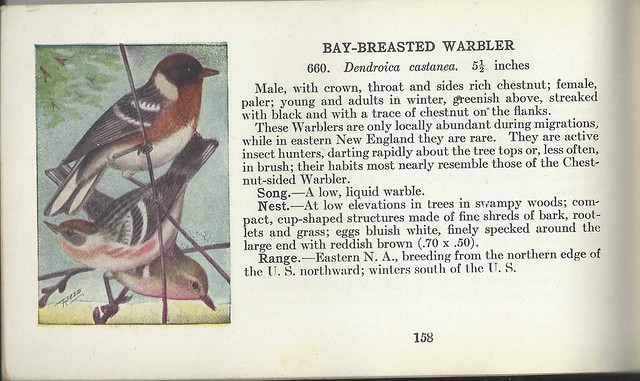
In the case of the Pine Warbler, Reed's illustration of the "duller and grayer" female would have been of little help, even at close range.
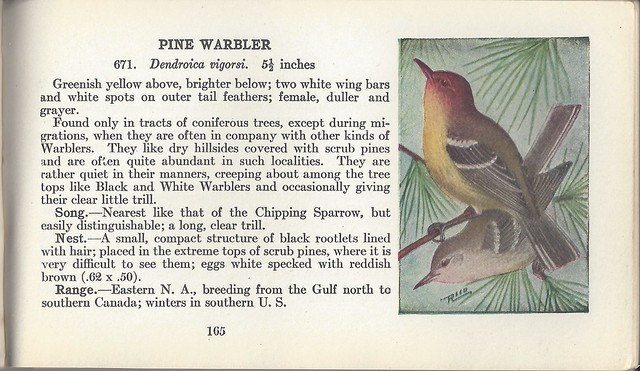
In pursuit of a Boy Scout Merit Badge, I started keeping a Life List in 1948, relying on my copy of Roger Tory Peterson's 1939 Revised and Enlarged First Edition of A Field Guide to the Birds, a gift from my mother a few years before. As I noted in an earlier blog, Roger Tory Peterson Centennial, she paid $2.75 for a used copy in 1942 (before my breakfast CheeriOats were renamed Cheerios). It would have cost $38.22 in today's economy, according to this Inflation Calculator, quite a sacrifice in those days.
Peterson provided better descriptions and awakened my interest in warblers, but was not much more helpful in addressing the differences between the three problem species as usually seen during fall migration.
For each of the "treacherous triad" the images of "autumn birds" had pointers which called attention to field marks.
- Blackpoll: "Olive-green above, two white wing bars, dingy yellow below, faintly streaked."
- Bay-breasted: Same description, except that it is "dingy buffy-yellow below," adding that it has yellow undertail coverts instead of white as in the Blackpoll.
- Pine: Similar to the other two, dull olive above, with a plain, unstreaked back and white undertail coverts.
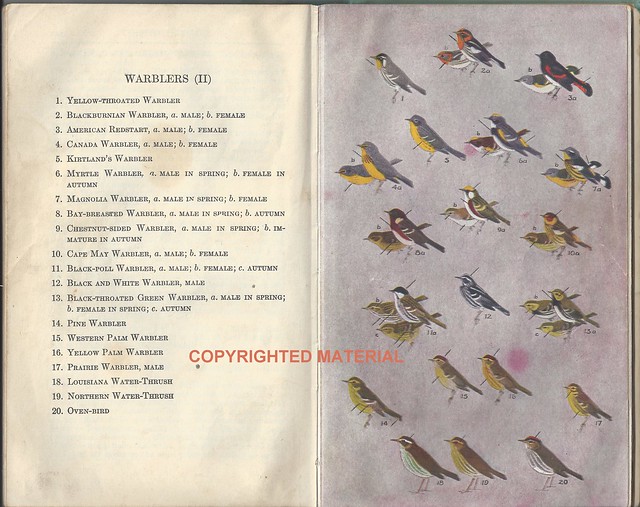
In his 1947 Second Revised and Enlarged Edition Field Guide, which I acquired about a year after I started my Life List, Peterson published this plate that depicted the "Confusing Fall Warblers."
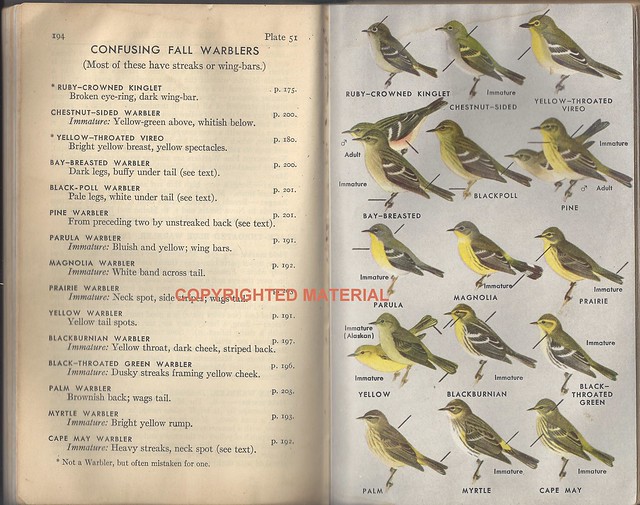
I wish he had not used that term "confusing." Although Peterson's intent was to sharpen the reader's birding skills, the illustrations had the opposite effect upon me, leaving me more perplexed than ever. Peterson's characterization simply legitimized my own confusion, especially in trying to distinguish the more common Blackpolls from Bay-breasted Warblers weaving about in the fall foliage!
Like most beginners, I learned useful ID tips from more experienced birders, but the "Confusing" three species were often cause for disagreements, even between the experts. I could sometimes separate the Pine Warblers from the other two. Autumn Blackpolls seemed to be more abundant than Bay-breasted, but too many of these went unidentified. Over the years, I came to call them simply "Baypolls."
To my rescue, some 65 years too late, Tom Stephenson and Scott Whittle's The Warbler Guide arrived on the birding scene. Before I received a copy, I expected it to be a rather slim publication. After all, the National Geographic Field Guide to the Birds of North America devotes a hefty 25 pages to the entire warbler tribe. Imagine my surprise to find that the massive Warbler Guide consists of 560 pages, packed with text, photographs and illustrations.

It arrived in time for our August through mid-September trip from Florida to our second home in NE Illinois. Before departing I read many of the 137 introductory pages. They dealt with such topics as warbler topography and what to notice about a warbler, including overall contrast and color, face and head patterns, size, shape, habitat, bill and leg color, breast, belly, back, rump, flanks, tail, wing and undertail coverts, aging and sexing, and seasonal and molt patterns.
Although I skimmed over the rather technical (for me) discussion of sonograms, the section on how to listen to sonograms presented useful general information about patterns and qualities of warbler songs.
Sixteen pages consist of about 80 thumbnail "quick finder" warbler illustrations on facing pages: side views, 45 degree views, under-views, faces, spring, fall and western regional comparative groupings, and finally unter-tail patterns. Toward the end of the book there is another "quick finder" for warblers in flight. This remarkable collection of photos and drawings, all sized proportionately and in full color, is worth the price of the book. I looked forward to applying what I learned during fall migration season in Illinois.
At the Fort Lauderdale airport, on our way to Illinois, our checked suitcase was two pounds overweight. I removed The Warbler Guide, thus reducing the weight by three pounds! Having cleared the luggage check-in without paying an extra tariff, I carried the book on the plane and immersed myself in the species accounts, jumping about, perusing those species I most expected (or hoped to see) during our stay in Illinois.
Thanks to the Peterson plate, I had almost given up on the fall Pine-Blackpoll-Bay-breasted triad. Now, having read Stephenson and Whittle's book, I paid special attention to wing patterns and leg color.
The Warbler Guide, in a departure from traditional field guides, provides many species with more than one set of descriptions and illustrations. "Bright birds" and "drab birds" deserve separate four-page accounts, as if they were different "species."
For example, the Bay-breasted Warbler has this second set of descriptions and comparisons for the "drab" form, particularly immatures, females and adult males in fall plumage.


This approach is very informative. One pearl that I harvested was to look for the high contrast black between the wing bars in the Bay-breasted, while the Blackpoll has more uniform dark olive wing coverts and flight feathers.
With somewhat increased confidence, I headed out into the field. Migration was slow, but I caught sight of this warbler, definitely one of the "Treacherous Triad:"
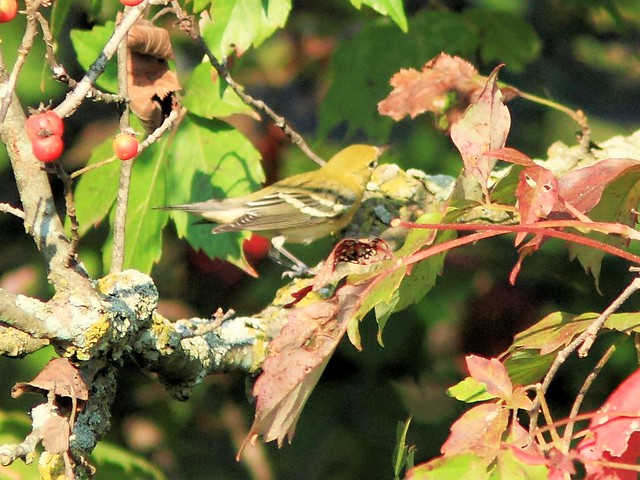
Its streaked back ruled out Pine Warbler. Noting the dark primaries and unstreaked breast, I was quite confident that it was a Bay-breasted Warbler. It confirmed my impression by moving up to provide a better view of its buffy flanks, and the definite darker area between the white wing bars:
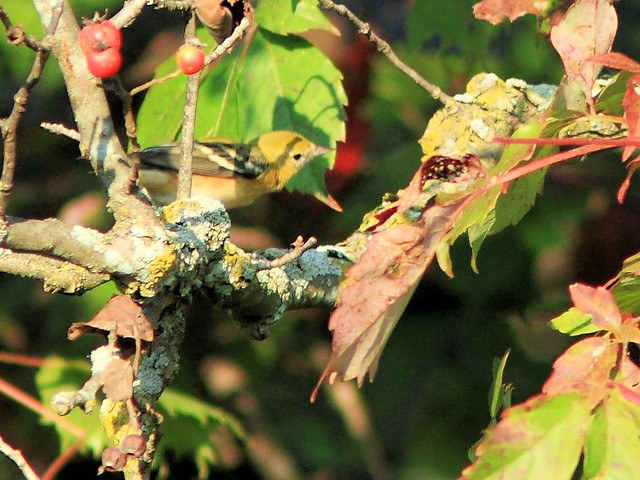
One of those "Baypolls" showed a rather pronounced eye-ring and streaked yellowish-olive breast and flanks. Its wings are more uniformly dark, and its legs are light colored, not black. I identified it as a Blackpoll:
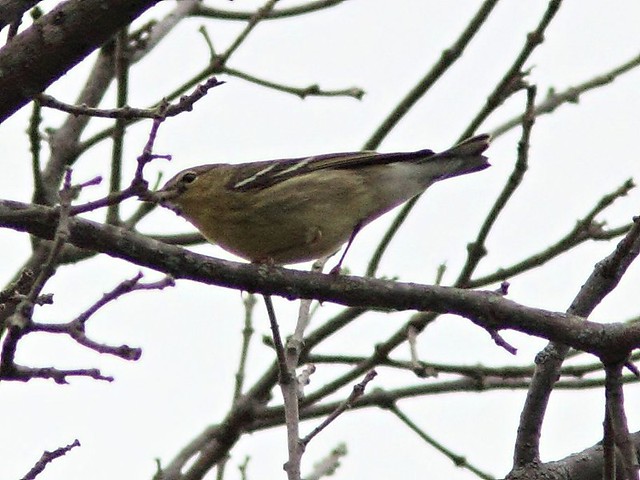
Another Blackpoll, with distinct yellow feet:

Buffy undertail coverts and breast reveal this as a Bay-breasted Warbler:
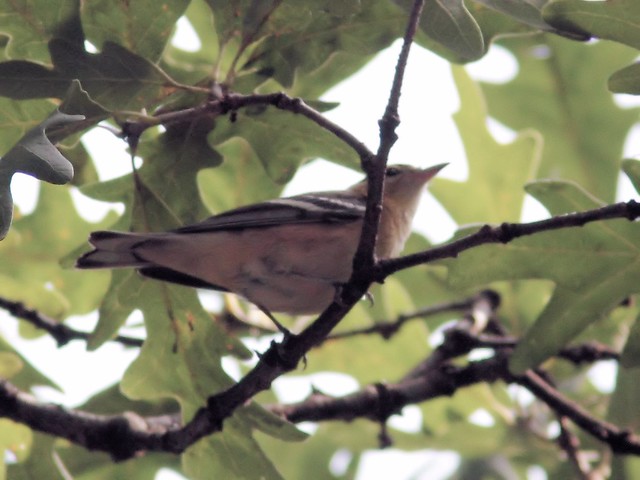
Fall warblering is fun and challenging, but how much easier in the spring, when the warblers match my childhood mental images...
Bay-breasted male (Illinois, May, 2009):
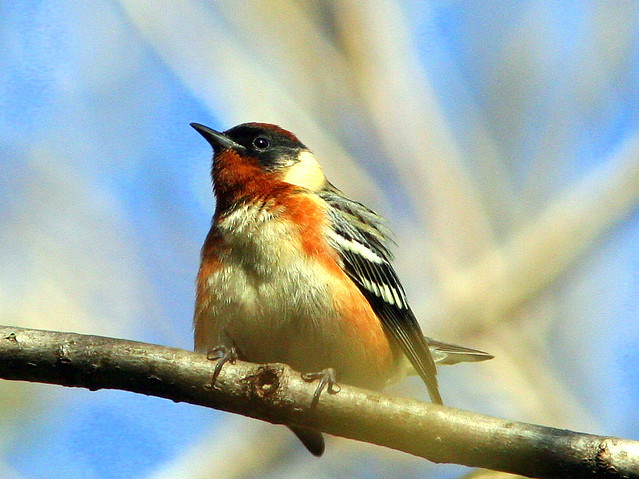
Male Blackpoll (Illinois, April, 2011):

Pine Warbler (March, 2011, South Florida):

Not a field guide to fit into one's pocket, and not a cocktail table adornment, this is a book to be visited time and time again... at my age, perhaps even more frequently than for most. It exhaustively illustrates the fine points of warbler identification, whether by size, shape, color, habits or vocalizations, and is a worthy addition to the library of any serious students of birds.
The Warbler Guide by Tom Stephenson and Scott Whittle (Jul 7, 2013)
(27)
| Formats | Price | New | Used | ||
|---|---|---|---|---|---|
| Flexibound | $22.54 | $18.62 | $18.10 | ||
| Kindle EditionAuto-delivered wirelessly | $16.17 |

Thank You Ken for sharing and I look forward to purchasing The Warbler.
ReplyDeleteKen, looks like a great warbler guide book, thanks for the review. Loved your warbler photos!
ReplyDeleteHi Ken,
ReplyDeleteI think I have a copy of that same book (from 1923) that I found at a church book sale. I was just referring to it for a class I'm taking. Check out my blog too....I used the cover in my title this week!
HI Ken Warblers are at times difficult to ID so thanks for sharing the book reviews with us. Great photographs as usual.
ReplyDeleteGreat job (as always) of providing some c o n t e x t in your review. Thanks!
ReplyDeleteGreat job (as always) in providing some c o n t e x t in your review. Thanks for writing this, Ken!
ReplyDeleteTerrific warbler shots Ken! I have trouble identifying warblers, might have to look into getting that book!
ReplyDeleteGreat photos and beautiful birds. It's very interesting to read about the field guides and how they have changed and become more detailed over the years.
ReplyDeleteBeautiful little birds.
ReplyDeleteKen you shared so much in this post; it is kind of nostalgic isn't it to still have that book with your pencilled notations. A brand new one to enjoy too. Lovely photos of beautiful birds you see.
ReplyDeleteThe Warblers are just so wonderful and I am happy to see the images shared from the bird guide. I still have a lot of trouble with ID of Warblers and Sparrows...oh my, there are so many, and then many look so similar~
ReplyDeleteVery nice review, Ken. I received my copy a couple of weeks ago and it's already been helpful. I have a long learning curve ahead of me! Now, if those little bundles of color would just hold still for a second.......
ReplyDelete